 W
WThe Helvetii, anglicized as Helvetians, were a Celtic tribe or tribal confederation occupying most of the Swiss plateau at the time of their contact with the Roman Republic in the 1st century BC. According to Julius Caesar, the Helvetians were divided into four subgroups or pagi. Of these Caesar names only the Verbigeni and the Tigurini, while Posidonius mentions the Tigurini and the Tougeni (Τωυγενοί). They feature prominently in the Commentaries on the Gallic War, with their failed migration attempt to southwestern Gaul serving as a catalyst for Caesar's conquest of Gaul.
 W
WThe Agri Decumates or Decumates Agri were a region of the Roman Empire's provinces of Germania Superior and Raetia; covering the Black Forest, Swabian Jura, and Franconian Jura areas between the Rhine, Main, and Danube rivers; in present southwestern Germany, including present Frankfurt, Stuttgart, Freiburg im Breisgau, and Weißenburg in Bayern. The only ancient reference to the name comes from Tacitus' book Germania. However the later geographer Claudius Ptolemy does mention "the desert of the Helvetians" in this area.
 W
WAquae Helveticae was a vicus and mineral spa established in the 1st century AD near the Roman legion camp of Vindonissa. It is in and was the origin of the name of Baden in Switzerland. It is a Swiss heritage site of national significance.
 W
WThe Battle of the Arar was fought between the migrating tribes of the Helvetii, and six Roman legions, under the command of Gaius Julius Caesar, in 58 BC. It was the first major battle of the Gallic Wars and ended in a tactical victory for the outnumbered Roman army.
 W
WAventicum was the largest town and capital of Roman Switzerland. Its remains are beside the modern town of Avenches.
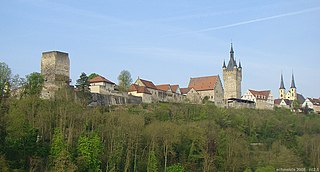 W
WBad Wimpfen (help·info) is a historic spa town in the district of Heilbronn in the Baden-Württemberg region of southern Germany. It lies north of the city of Heilbronn, on the river Neckar.
 W
WThe Battle of Bibracte was fought between the Helvetii and six Roman legions, under the command of Gaius Julius Caesar. It was the second major battle of the Gallic Wars.
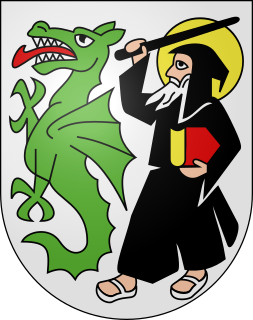 W
WBeatus of Lungern, known also by the honorific Apostle of Switzerland or as Beatus of Beatenberg or Beatus of Thun, was probably a legendary monk and hermit of early Christianity, and is revered as a saint. Though his legend states that he died in the 2nd century, it is likely that his story has been conflated with other saints of the same name, especially Beatus of Vendôme, and an Abbot Beatus who received a charter in 810 from Charlemagne to confirm that Honau Abbey would be administered by Irish monks.
 W
WDivico was a Celtic king and the leader of the Helvetian tribe of the Tigurini. During the Cimbrian War, in which the Cimbri and Teutons invaded the Roman Republic, he led the Tigurini across the Rhine to invade Gaul in 109 BC. He defeated a Roman army near present-day Agen on the Garonne river and killed its leaders Lucius Cassius Longinus and Lucius Calpurnius Piso Caesoninus during the Battle of Burdigala in 107 BC. Eventually he led his people back to the tribes of the Helvetii, near present-day Switzerland where they settled in the Jura Mountains near Lac Leman. 49 years later, before the Battle of Bibracte, he led a delegation back to Gaul to negotiate for a safe passage for his tribe through the Roman region of Provence. The request was denied by Caesar who wanted revenge for a relative who had been killed in the battle near Agen in 107 BC.
 W
WLumnezia is a valley region and a municipality in the Surselva Region in the Swiss of canton of Graubünden. The former municipalities of Cumbel, Degen, Lumbrein, Morissen, Suraua, Vignogn, Vella, and Vrin merged on 1 January 2013 into the new municipality of Lumnezia. It covers the (Val) Lumnezia, a Swiss high alpine valley. Its upper regions are among the most remote areas in the Swiss Alps. The official language is Romansh Sursilvan.
 W
WLe Mormont is a hill in the Swiss canton of Vaud, rising to an elevation of 605 metres, with a prominence of about 115 metres. It is part of the Éclépens municipality. The name is first recorded in AD 814, as Mauromonte. It is derived from the Roman-era personal name Maurus.
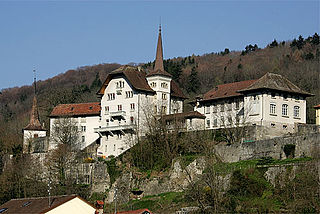 W
WMoudon is a municipality in the canton of Vaud in Switzerland. It was the seat of Moudon District and is now in the Broye-Vully district.
 W
WNoviodunum or Colonia Iulia Equestris was a Roman era settlement in what is now Nyon in the Canton of Vaud in Switzerland.
 W
WNyon is a municipality in Nyon District in the canton of Vaud in Switzerland. It is located some 25 kilometers north east of Geneva's city centre, and since the 1970s it has become part of the Geneva metropolitan area. It lies on the shores of Lake Geneva and is the seat of Nyon District. The town has a population of 21,452 and is famous in the sporting world for being the headquarters of the Union of European Football Associations (UEFA) and the European Club Association (ECA). It is connected to the rest of Switzerland by way of the Route Suisse, the A1 Motorway and the railways of the Arc Lémanique.
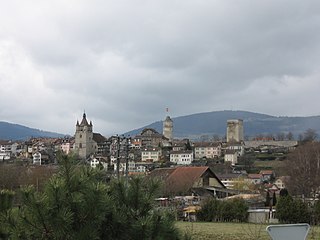 W
WOrbe is a municipality in the Swiss canton of Vaud. It was the seat of the former district of Orbe and is now part of the district of Jura-Nord Vaudois.
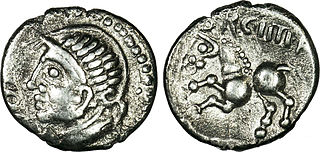 W
WOrgetorix was a wealthy aristocrat among the Helvetii, a Celtic-speaking people residing in what is now Switzerland during the consulship of Julius Caesar of the Roman Republic.
 W
WThe Tigurini were a clan or tribe forming one out of four pagi (provinces) of the Helvetii. The Tigurini were the most important group of the Helvetii, mentioned by both Caesar and Poseidonius, settling in the area of what is now the Swiss canton of Vaud, corresponding to the bearers of the late La Tène culture in western Switzerland. Their name has a meaning of "lords, rulers". The other Helvetian tribes included the Verbigeni and the Tougeni, besides one tribe that has remained unnamed.